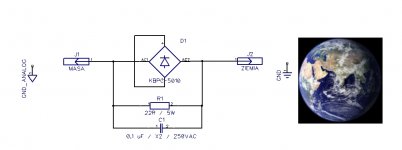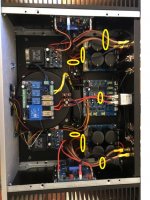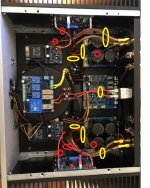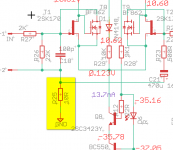Maybe worth trying?There is no connection between audio ground and chassis. Chassis is connected to mains earth.
This is a parallel connection of
a). A rectifier bridge, 50A/1000V, with shorted plus and minus,
b). 100nF / X2 certified / 275VAC
c). 2.2 ohms resistor, 10W. (as in 2 point 2 ohms: missing dot on the drawing).
The elements are somewhat over-sized, because they need to survive a critical event, that hopefully never happens.
Attachments
Did you try a Zobel directly on output of each transformer secondary?
Example: 100nF + 75 ohms ?
(series connected)
Example: 100nF + 75 ohms ?
(series connected)
That could be a problem
I have another FC100 amp, same PCB layout, pretty much same chassis only bigger. It also does not have audio ground connected to chassis, and yet no hum. No snubber diodes, no wire twisting, etc.
The difference is in transformers only - noisy one uses single 500VA industrial transformer, silent one uses two 250VA potted transformers.
This is why I was inclined to go for transformer change. If it was a BUZZ, I'd start looking at ground loops, but it's a HUM.
Did you try reversing the leads of the transformer primary?
In case that it is a toroidal transformer: is the "Live" mains wire routed to the *beginning* of the primary winding? (As in: not to the end of the winding)?
Do you know how to measure "where" is the beginning, and where is the end of the primary winding?
As in which of the two leads is which?
In case that it is a toroidal transformer: is the "Live" mains wire routed to the *beginning* of the primary winding? (As in: not to the end of the winding)?
Do you know how to measure "where" is the beginning, and where is the end of the primary winding?
As in which of the two leads is which?
Can you paste some photos with details of the transformer, and the ground returns, general cabling, stuff like that?
Did you try reversing the leads of the transformer primary?
In case that it is a toroidal transformer: is the "Live" mains wire routed to the *beginning* of the primary winding? (As in: not to the end of the winding)?
Do you know how to measure "where" is the beginning, and where is the end of the primary winding?
As in which of the two leads is which?
I am in Belgium, there is no neutral. They are both live.
That's good. Quite often people come here with hum problems and it's connecting 0V to chassis that cures it.I have another FC100 amp, same PCB layout, pretty much same chassis only bigger. It also does not have audio ground connected to chassis, and yet no hum. No snubber diodes, no wire twisting, etc.
Why do you think the hum from the speakers is anything to do with the transformer?
I think its due to running unshielded mains wiring above the preamp pcb (if I understand that photo correctly).
I think its due to running unshielded mains wiring above the preamp pcb (if I understand that photo correctly).
Yup. Or at least tightly twisting those two together.Why do you think the hum from the speakers is anything to do with the transformer?
I think its due to running unshielded mains wiring above the preamp pcb (if I understand that photo correctly).
Actually, I missed out on that photo pasted at the beginning of the thread. Looking at the photo now, I see ample opportunity to twist some other leads together too. Pairs. Triplets.
Ziggy would be twisting in there quite heavily.
If my understanding of the cabling topology is correct, I would twist together the ones embraced by painted yellow ellipses.
...
What I would also do is re-check, that the screen from each of the RCA input jacks is isolated from the chassis: no electrical connection between the RCA outer body and amplifier chassis.
Attachments
Last edited:
What is the function / role of the single unpaired wires, as marked in red on modified picture below?
Would it be possible to twist them together with their direct peers?
Why does the black one go somewhere totally different, geographic-wise, than the other two?
If these are Rail+, Rail- and Analog-GND, would it be possible to make a twisted triplet out of them?
Would it be possible to twist them together with their direct peers?
Why does the black one go somewhere totally different, geographic-wise, than the other two?
If these are Rail+, Rail- and Analog-GND, would it be possible to make a twisted triplet out of them?
Attachments
If you are getting hum from the speakers, it would suggest an electrical problem that may be putting an non-symmetrical load on the transformer causing it to mechanically hum. Take a close look at the transformer load - bridge rectifier? Are all the diodes good with none of them breaking down? Filter caps? are they failing?
Why do you think the hum from the speakers is anything to do with the transformer?
+1
The buzz will very likely need a dc trap to eliminate.
1. Try rotating the transformer. That's what cured my hum finally.
2. How many secondaries do you have? Are the two channels fed by separate secondaries? If not, you will have hum.
2. How many secondaries do you have? Are the two channels fed by separate secondaries? If not, you will have hum.
Not necessarily, it can be contributory to a cross channel ground loop.Are the two channels fed by separate secondaries? If not, you will have hum.
Not necessarily, it can be contributory to a cross channel ground loop.
Yes, that's what I meant. Sorry if the terminology was inaccurate, but the cross channel ground loop will manifest as hum on the speakers.
Yes, separate supplies means that loop can't exist, I was only saying a shared supply doesn't mean it's guaranteed.
Thanks for all the replies.
1. Twisted mains wires - no change
2. twisted speaker wires - no change
3. Connected chassis to ground - hum/buzz went up significantly - disconnected again.
4. Did a following test since my pre is muting outputs when transformer is off - connected right input directly to right channel on the amp, fired it up, buzzing went worse. Played some music on low volume. Now, I could turn off the transformer without muting the inputs/outputs on pre - music was still playing for few more seconds until caps went out of charge - without buzz/hum.
1. Twisted mains wires - no change
2. twisted speaker wires - no change
3. Connected chassis to ground - hum/buzz went up significantly - disconnected again.
4. Did a following test since my pre is muting outputs when transformer is off - connected right input directly to right channel on the amp, fired it up, buzzing went worse. Played some music on low volume. Now, I could turn off the transformer without muting the inputs/outputs on pre - music was still playing for few more seconds until caps went out of charge - without buzz/hum.
Yes, that's what I meant. Sorry if the terminology was inaccurate, but the cross channel ground loop will manifest as hum on the speakers.
I have only two secondaries, both are connected to both channels. Each channel runs separate bridge for positive and negative rail.
Are You sure it's not the chassis humming vibrating or even vibration coupling through the furniture ? Try to put some rubber feet underneath the chassis. You said You have two lives. In Belgium I believe You have a live phase and a neutral wire or three live phases and a neutral and of course the PE earth wire should be there also. I lived in Germany so standards are the same. If you connect two live wires (black or / and brown) You are feeding the trany with 400V and not 230V. Neutral wire is usually blue. The one that doesn't light the screwdriver neon lamp.
- Home
- Amplifiers
- Solid State
- Transformer HUM.




